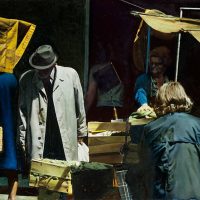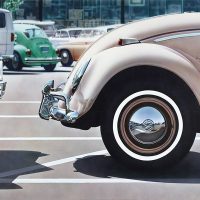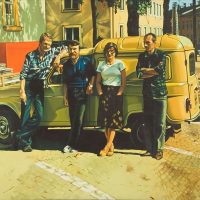France Berko Bercic: My all time favourite bicycle, acryl on canvas, 200 x 200 cm, 1975, Museum of Contemporary Art, Zagreb
Tibor Csernus: Market, oil on canvas, 130 x 162 cm, 1973, KOGART Archive
Don Eddy: Untitled (Volkswagen), acryl on canvas, 122 x 152 cm, 1971, Photo © MUMOK, Museum moderner Kunst Stiftung Ludwig Wien, Leihgabe der Österreichischen Ludwig Stiftung
Andrzej Sadowski: Group Portrait with the yellow Renault, oil on canvas, 60 x 73 cm, 1978, Courtesy of Zacheta National Gallery of Art
Photorealism came into its own at the end of the 1960s, arising from the challenge posed by photographic depiction to realist painting, and is mostly associated with well-known American and Western European artists and their works. The Budapest Ludwig Museum exhibition expands the scope of earlier shows in Vienna (MUMOK, 22 October 2010 – 13 February 2011) and Aachen (Ludwig Forum für Internationale Kunst, 13 March – 19 June 2011), both of which included materials from the Ludwig’s collection. Our exhibition offers new approaches to similar Central- and Eastern European tendencies by virtue of a complex interpretation of Cold War realism.
True-to-life photographic representation and analytical depiction also found followers on the Eastern side of the Iron Curtain, although not in the same measures or with the same convictions as in the West. The different political and cultural contexts, the long-standing historical tradition of realism and the lack of an art market or consumer culture meant that East European photo-based realism faced fundamentally different perspectives. In many countries of the former Soviet Block, art of the recent past had to exist in relation to ideological Socialist Realism, and despite the fact that realist depiction enjoyed local traditions stretching back over centuries, realist representation was somewhat discredited, its critical potential weakened. It took some time for realism to free itself from the ideological constraints promoted and expected by the authorities.
At the end of the 1960s, the advent of photorealism in the former Soviet Block represented a ‘reclaiming’ of realist depiction, and a dialogue with Western art. This not only ran counter to the state-funded version of ideologically charged realism, but was also estranged from neo-avantgarde works of the time and their occasionally narrow, elitist attitudes. Photorealism was not concerned with publicizing its political allegiances, yet its detachment and outsider quality were useful for the purposes of veiled social criticism, since its obvious everyday character rendered it beyond reproach for the authorities. At the same time, everyday themes and scenes opened the door to symbolic interpretation, the analogies of reading between the lines or behind the pictures, and social historical analyses of depiction.
The fine arts aspect of photography is a rich and much-discussed theme in Central- and Eastern Europe, yet within this photorealism has, to date, represented a relatively marginal chapter. The excessively literal rewriting of photography, over-concentration on model modes of depiction and technical precision have suppressed personality and danger: these are well-known arguments that have neglected the politics concealed by choice of source image and theme. Unlike the entirely other world of taut magazine covers, perfectly rendered advertising images and workshop settings, well-meaning and moderately successful family or press photographs shift the emphasis from the challenge to depict, to that of reality.
The exhibition deliberately shifts our expectations of style, and discusses the metonymic understanding of photorealism as a terminus to allow us to appreciate parallels and dissimilarities, and the various aims and intentions, rather than merely placing works in competition with one another or listing influences.
Artworks were selected not on the basis of normative, depictive quality. The declared aim of photorealism, photo-illusion (the especially popular fields of street reflections, or the labyrinthine lines of the face) was frequently subsumed by another dimension, namely everyday life during the Cold War and the realistic depiction of the economy of shortage. In many instances, choice of subject and critical perspectives played a more important role in our selection than technical precision deployed to examine the gaze and representation.
The exhibition includes works from internationally-recognised names as well as forgotten artists, thus allowing us to reconsider the recent past through the lenses of an artistic trend in its many forms.



